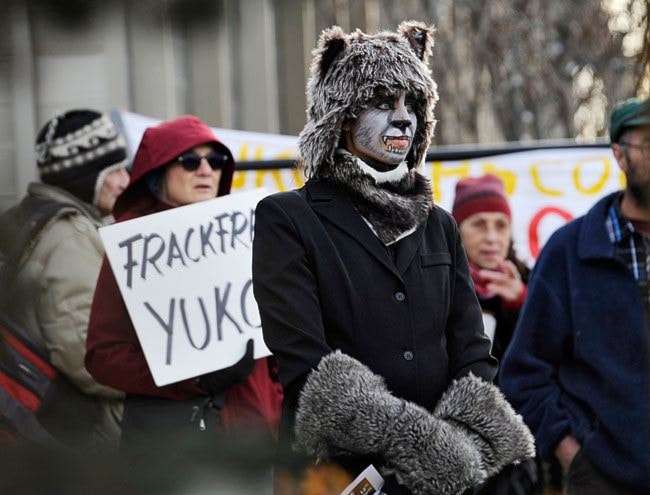Jody Overduin came to the opening day of the Yukon legislative assembly in a wolf costume, but it was no Halloween joke.
She was one of about 60 protesters who shivered outside the government administration building to voice their opposition to hydraulic fracturing and burning liquefied natural gas in the territory.
Overduin is the outreach co-ordinator for Yukon’s chapter of the Canadian Parks and Wilderness Society. The group speaks on behalf of the environment and the wildlife, including her favourite animal, the wolf, she said.
“What is clear about fracking is that it takes an enormous amount of water, and that then turns into hazardous liquid waste,” she said. “What is clear is that wildlife habitat is mowed down in order to build well platforms, and access roads are spreading like cancer to each well. What is clear is that, in the end, LNG is still a non-renewable resource, meaning that after all that destruction, we still do not have a long-term solution.”
Yukon Energy has a plan to replace aging diesel generators with liquefied natural gas generators, which the corporation says will save Yukoners money and be better for the environment.
That proposal is currently before the Yukon Environmental and Socio-economic Assessment Board.
Protesters came with the message that natural gas development is equal to fracking, and it should be opposed even if it is happening outside of Yukon and even if Yukon Energy currently has a contract to buy conventional gas.
Malcolm Mills, who represented the Yukoners Concerned about Oil and Gas Exploration/Development, said it is a hopeful sign to see the industry representatives fighting back in the media.
Kevin Heffernan, president of the Canadian Society for Unconventional Resources, spoke with the Yukon News last week in advance of his visit to the territory.
“In looking at the media lately, we’re starting to see the other side being a little bit more vocal, which actually gets me really excited,” said Mills. “When we started this process, coming up on two years ago, we were told that we were a group of radicals, we didn’t know what we were talking about, we didn’t have the engineering principles or the capacity to understand the engineering principles involved in this industry.
That industry is fighting back “means we’re winning,” said Mills. “It means that we’re making an impact. We’re starting to take the debate away and out of their control, because we have become educated. We have become vocal, we have become unified.”
J.P. Pinard, an engineer and expert on wind power technology, urged Yukoners to tell the assessment board that they do not want natural gas power in the Yukon.
“Please write letters to YESAB about it, saying, ‘No, we don’t want it. No, we don’t want to invest our money into more fossil fuel for the Yukon.’ Remember, Yukon Energy’s going to have to borrow $40 million for this, and you know where that money is going to come from? It’s going to come from all of you.”
That money should be invested instead in developing renewable power, he said.
Yukon Energy’s proposal has not yet been opened up for public comment, and is currently in the adequacy review stage.
The fracking debate continued inside the legislature, when NDP MLA Kate White asked the minister of Energy, Mines and Resources to explain where all the water necessary to support fracking in the Yukon would come from.
“To put it mildly, fracking is water-intensive,” said White. “A single moderate-sized hydraulic fracture uses 1,000 tonnes of sand, 300 cubic metres of chemical additives and 15,000 cubic metres of water. To help visualize what these numbers mean, that’s 40 B-train trucks of sand, seven B-train trucks of chemicals and 500 B-trains to deliver fresh water to the well site—and this is only on one single frack job.
“The average well is fracked 12 times to get it into production and many need to be fracked on an ongoing basis to maintain production levels. On a typical pad site, there are 12 to 16 wells.”
These numbers came from Energy, Mines and Resources, she said.
A legislative committee has been formed to review the risks and benefits of fracking before it is allowed in the territory.
Energy Minister Scott Kent said he is waiting to see what that committee reports back to the legislature in spring 2014 when its recommendations are due.
“It’s an emotional issue for Yukoners. It’s an emotional issue across the country and indeed around the world, when it comes to hydraulic fracturing. I have the confidence in the members who sit on that select committee that they will go in and be able to separate that emotion. It’s sometimes a difficult job.”
Contact Jacqueline Ronson at
jronson@yukon-news.com
